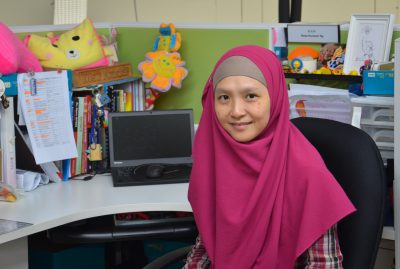Create a Positive and Engaging Classroom in 5 Ways
Ms Nada Nurwani Ng, teacher at Hwa Chong Institution, gives off a very youthful vibe that could have anyone mistaking her for a beginning teacher when in fact, she is a veteran who has taught for more than 18 years. As an avid proponent of positive teaching, she shares with us five of her personal tips in creating a positive and engaging classroom based on her own experiences.
1. Have Self-care and a Positive Mindset
As role models for students, it is crucial that the teacher must first care for himself or herself to effectively demonstrate positivity in the classroom. “I think this is the most important point of all. You are what you bring to the classroom,” shares Nada.
It also takes conscious effort to cultivate a positive mindset and look for the silver lining especially when faced with a challenging situation. One way is to care for yourself first before you can bring a positive mindset into the classroom.
2. Build Relationships
It is important for teachers to build a relationship with their students that goes beyond just talks on examinations and grades. Take the time to chat with students about topics unrelated to school. To Nada, building relationships with her students is crucial even if that means having to invest her time to do certain activities together. Note that relationship goes two ways – teachers should also be ready to share about themselves.
“I will ask them questions like ‘who do you eat with during recess?’, ‘how much does the food cost in the canteen?’, ‘how much is your pocket money?’” Nada says. Such conversations give her the opportunity to know more about her students. It also gives her the chance to follow up with them on issues that the students may have mentioned in passing.
3. Establishing Rituals and Stability
Having consistent activities are especially helpful for Secondary 1 students transiting into their new learning environment, as the transition may get quite overwhelming for them. Rituals such as starting the year with a cheer at the first assembly, partaking in a tau huay (soya beancurd) party or ice cream day just before the exams help to give students an air of anticipation and excitement, explains Nada.
Nada shares that such rituals, or activities, are purposefully planned throughout the year to give the students a sense of stability and structure. Different teachers may also implement their own smaller scale classroom rituals.
Nada starts off each first lesson of the term by listing out the things she will be doing with the students for the whole term. “It’s that consistency and things that they can expect, which becomes very comforting for them.”
4. Use Positive Language
Building positivity with words can help create a positive and engaging classroom. While some words might not mean much to some, students can be sensitive to certain words, causing damage to their development. As such, Nada advises that teachers have to be very mindful of the language used.
“We have to constantly help our students to rephrase their words when they talk about their abilities and help them build a growth mindset with positive words.” She stresses that the language used is very important. The relationships built with students coupled with the use of positive language provide them a safe environment to learn and try new things.
5. Bring Your Own Strengths into the Classroom
One of Nada’s advice for teachers is to bring what you are good at into the classroom. “Don’t try to be somebody else,” she advises. One teacher’s classroom management style may be very good and effective but not everyone may be able to emulate the same style.
Nada uses her chatty nature to engage her students in conversations and through that, relationships are built with her students, giving her the ability to influence them positively. “If you ask somebody to do my style (of classroom management), that person may not be able to. So don’t be who you are not.”
She shares about a colleague who is good with musical instruments and plays them with his class, as well as another colleague who is good with baking and bakes for the students. “Bring who you are into the classroom and be very authentic about it,” urges Nada. “Use whatever you are good at as an anchor and a vehicle to build relationships.”







